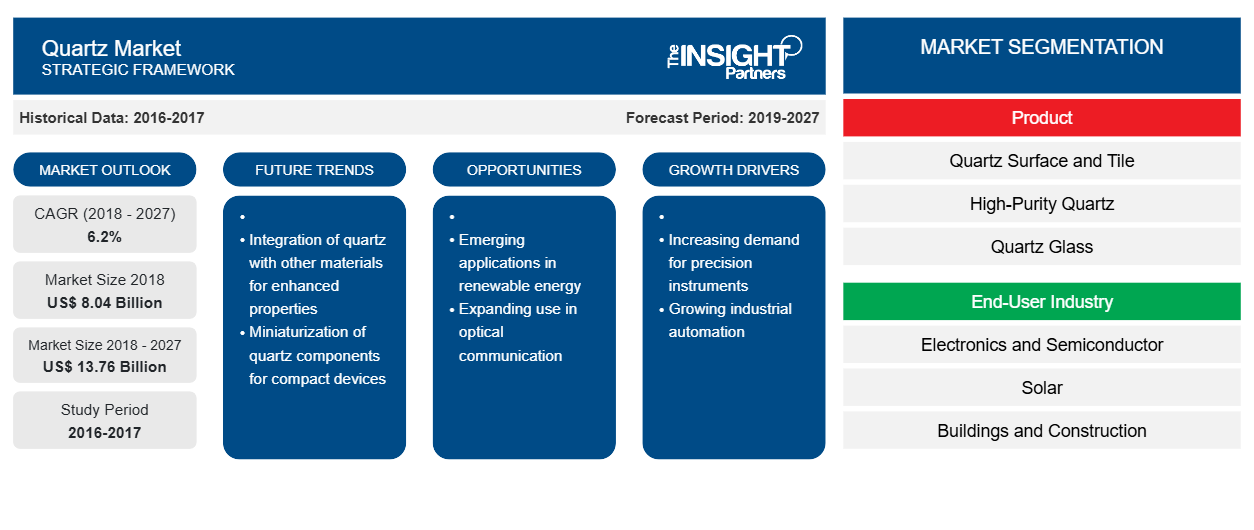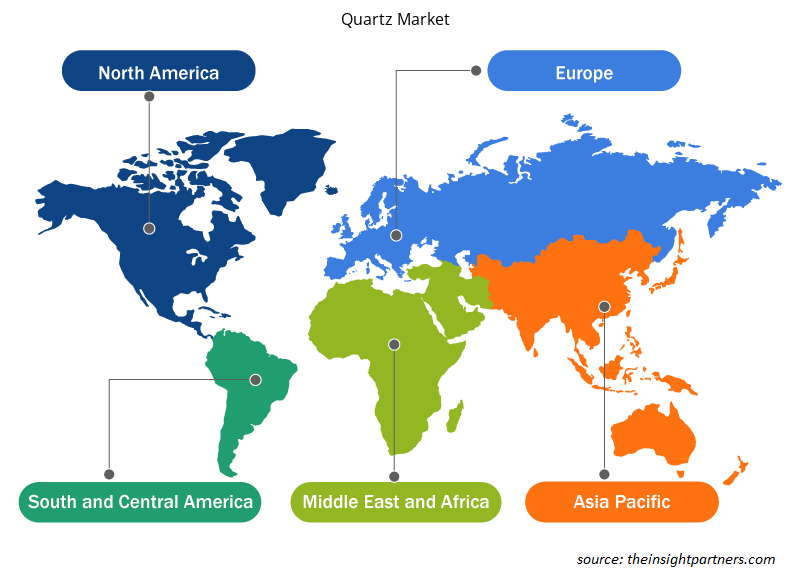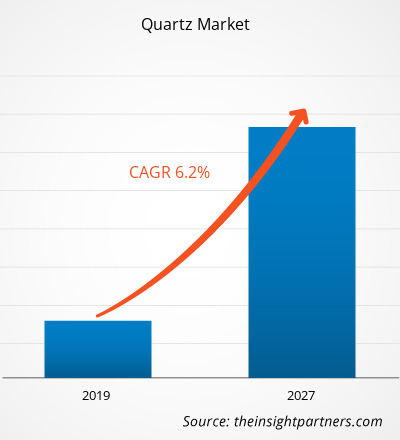The quartz market accounted for US$ 8,037.0 Mn in 2018 and is expected to grow at a CAGR of 6.2% during the forecast period 2019 - 2027, to account to US$ 13,762.6 Mn by 2027.
Quartz is a mineral form of SiO2 stable at low temperatures and pressures. It is found in igneous, sedimentary, metamorphic, and hydrothermal mineral environments, mainly in continental regions. It is highly resistant to mechanical and chemical weathering, and the high durability makes it the dominant mineral of mountaintops and the primary constituent of river, beach, and desert sand.
The Asia Pacific region held the largest market share in the global quartz market. The region is dominated by the presence of a number of quartz manufacturers such as Caesarstone, Hanwha L&C, Dupont Cosentino Group, among others, propels the quartz market growth. The rapid adoption of innovative and advanced technologies by these players in order to improve operational efficiency is expected to boost the APAC quartz market during the forecast period. Increasing industrial development coupled with rising government investments towards the automotive & electrical and electronics infrastructures is expected to fuel the quartz market in the upcoming years. Also, the increasing research and development investments for quartz production is estimated to boost the quartz market growth in the Asia-Pacific region. India, China, and Japan are the largest countries, contributing to the overall quartz market in the Asia-Pacific.
Customize This Report To Suit Your Requirement
You will get customization on any report - free of charge - including parts of this report, or country-level analysis, Excel Data pack, as well as avail great offers and discounts for start-ups & universities
Quartz Market: Strategic Insights

- Get Top Key Market Trends of this report.This FREE sample will include data analysis, ranging from market trends to estimates and forecasts.
You will get customization on any report - free of charge - including parts of this report, or country-level analysis, Excel Data pack, as well as avail great offers and discounts for start-ups & universities
Quartz Market: Strategic Insights

- Get Top Key Market Trends of this report.This FREE sample will include data analysis, ranging from market trends to estimates and forecasts.
Market Insights
Abundant availability and wide range applications of quartz to propel the quartz market
Quartz finds usage in a wide range of applications in industries such as electronics and semiconductor, solar, buildings and construction, medical, and optics and telecommunications. Quartz is naturally available in different varieties, shapes, transparencies, and colors, which further increase its value and application. Different types of colored quartz are considered semi-precious gemstones, and they are often used in jewelry and stone carving. Amethyst, ametrine, citrine, and opal are precious or semi-precious gemstones that are widely used in jewelry for their color and durability. On grounding quartz into quartz sands, it can be used in the production of fiberglass, and as an abrasive in sandblasting and stone-cutting. Pure quartz sand is extensively used in water purification systems. Small chips produced of quartz are used in watches, televisions, clocks, computers, and stereos as quartz when under pressure has the potential to produce an electric voltage that can control the frequencies of electric impulses.
Rising Demand for Synthetic Quartz is expected to boost the quartz market globally
Synthetic quartz offers various beneficial properties such as resistance to acids, corrosion, high temperatures, impact, wear, compression, bending, and infiltration. Therefore, it is extensively used in the electronics and semiconductor industry. Synthetic quartz is most prominently used in optical components that are used in wavelength lasers of microlithography projection systems. The optical components made of synthetic quartz are used to transmit high-energy ultraviolet laser radiation for producing large-scale integrated circuits. Synthetic quartz components are highly resistant to laser, which makes them suitable for high-power or short-wavelength lasers. Synthetic quartz is also used to manufacture crucibles that pull single crystal silicon used to produce semiconductor devices and solar cells. High purity quartz is further used for single crystal ingots from silicon metal in the solar industry. Currently, most of the quartz crystals used in optical instruments and electronic components are produced in laboratories instead of extracting from mines. Therefore, the easy availability of synthetic quartz and its application in various industries, such as electronics & electrical, automotive, and construction, are among the factors boosting the demand for synthetic quartz and impacting the quartz market globally.
Product Insights
On the basis of product, the global quartz market has been segmented into quartz surface and tile, high-purity quartz, quartz glass, quartz crystal, quartz sand, and others. Under the products segment, the quartz surface and tile market led to the global quartz market. Moreover, the high-purity quartz segment is anticipated to register the fastest CAGR over the projected period. High purity quartz (HPQ) has a negligible amount of impurities and is produced with more than 99% silicon dioxide. HPQ is used in industries such as semiconductor, solar, fiber optics, and lighting. High purity fused quartz is made from high purity quartz and offers a wide range of optical, mechanical, and thermal properties that are essential for manufacturing various high-tech products. Growing demand for high purity quartz from the semiconductor industry is the primary factor driving its demand globally. In the semiconductor industry, HPQ is used for applications such as in the production of tubes, crucibles, and rods.
End-User industry Insights
The global quartz market by the end-user industry has been segmented into electronics and semiconductor, solar, buildings and construction, medical, optics and telecommunication, and others. The electronics and semiconductor segment accounted for the largest share in the global quartz market. Quartz is widely used in electronic devices such as resonators to provide stable performance. Naturally occurring pure quartz is used for growing silicon wafers in the semiconductor industry. Pure quartz sand is used to produce silicon metal semiconductors for transistors, in the development of integrated circuits, microelectronics, and the silicon chip. Quartz is also used as a piezoelectric cell that produces electricity when applied stress and even has a converse effect.
Mergers and acquisitions were observed as the most adopted strategies in the global quartz market. Few of the recent developments in the global quartz market are listed below:
2019:Saint Gobain SA conducted R&D for new possible applications.
2017:Quality Quartz Engineering has been selected to deliver design development work on a load-bearing quartz rod integral to the energy supply of the world’s largest fusion reactor.
Quartz Market Regional Insights
The regional trends and factors influencing the Quartz Market throughout the forecast period have been thoroughly explained by the analysts at Insight Partners. This section also discusses Quartz Market segments and geography across North America, Europe, Asia Pacific, Middle East and Africa, and South and Central America.

- Get the Regional Specific Data for Quartz Market
Quartz Market Report Scope
| Report Attribute | Details |
|---|---|
| Market size in 2018 | US$ 8.04 Billion |
| Market Size by 2027 | US$ 13.76 Billion |
| Global CAGR (2018 - 2027) | 6.2% |
| Historical Data | 2016-2017 |
| Forecast period | 2019-2027 |
| Segments Covered |
By Product
|
| Regions and Countries Covered | North America
|
| Market leaders and key company profiles |
Quartz Market Players Density: Understanding Its Impact on Business Dynamics
The Quartz Market is growing rapidly, driven by increasing end-user demand due to factors such as evolving consumer preferences, technological advancements, and greater awareness of the product's benefits. As demand rises, businesses are expanding their offerings, innovating to meet consumer needs, and capitalizing on emerging trends, which further fuels market growth.
Market players density refers to the distribution of firms or companies operating within a particular market or industry. It indicates how many competitors (market players) are present in a given market space relative to its size or total market value.
Major Companies operating in the Quartz Market are:
- Caesarstone Ltd
- Thermo Fisher Scientific Inc.
- Sibelco
- E. I. DU Pont De Nemours and Company
- Saint Gobain S.A.
Disclaimer: The companies listed above are not ranked in any particular order.

- Get the Quartz Market top key players overview
GLOBAL QUARTZ MARKET SEGMENTATION
Global Quartz Market - By Product
- Quartz Surface and Tile
- High-Purity Quartz
- Quartz Glass
- Quartz Crystal
- Quartz Sand
- Others
Global Quartz Market - By End-User Industry
- Electronics and Semiconductor
- Solar
- Buildings and Construction
- Medical
- Optics and Telecommunication
- Others
Global Quartz Market - By Geography
North America
- U.S.
- Canada
- Mexico
Europe
- Germany
- France
- Italy
- UK
- Russia
- Rest of Europe
Asia Pacific
- Australia
- China
- India
- Japan
- South Korea
- Rest of Asia Pacific
Middle East and Africa (MEA)
- South Africa
- Saudi Arabia
- UAE
- Rest of MEA
South America
- Brazil
- Argentina
- Rest of South America (SAM)
Company Profiles
- Caesarstone Ltd
- Thermo Fisher Scientific Inc.
- Sibelco
- E. I. DU Pont De Nemours and Company
- Saint Gobain S.A.
- Creswick Quartz
- Quartz Corporation
- Momentive Performance Materials Inc.
- Baba Quartz
- Quality Quartz Engineering
Frequently Asked Questions
On the basis of end-user industry, metal quartz is expected to grow at a faster pace during the forecast period of 2019-2027, why?
Building and construction industry is expected to grow at a faster pace during the forecasted period. Increasing demand for quartz surfaces and tiles in residential and commercial sectors is projected to boost the demand for quartz from the building and construction industry. Moreover, quartz kitchen countertops are gaining popularity due to their durability and stain resistance properties. Due to the increasing popularity of quartz countertops, many American and European producers are innovating new products by mixing quartz material with different types of resin. Additionally, quartz is a cheaper alternative to natural stone, such as marble countertops and granite countertops. These factors are propelling the demand for quartz in the building and construction sector.
Mention some of the major players operating in the global quartz market?
The major players operating in the global quartz market, includes Baba Quartz, Quality Quartz Engineering, Momentive, Quartz Corporation, Creswick Quartz, Saint Gobain S.A., Dupont, Sibelco NV, Thermofisher Scientific, and Caesarstone Ltd among others.
Which region has accounts to hold the largest share for the global quartz market?
The quartz was dominated by the Asia Pacific at a global level. The largest market share of this region is primarily attributed to the presence of major quartz manufacturers in the region. Increasing demand for quartz from the electronics industry in developed and developing countries in the APAC countries such as China, Japan, South Korea, and India is propelling the growth of the quartz market in APAC. Furthermore, the well-established building and construction sector in the Asian countries provides a huge market opportunity for the key players operating in the quartz market. The quartz and quartz products produced in Asian countries, such as China and India, are mainly exported to the US, Germany, and France. This further provides a huge customer base for quartz products manufactured in APAC.
- Historical Analysis (2 Years), Base Year, Forecast (7 Years) with CAGR
- PEST and SWOT Analysis
- Market Size Value / Volume - Global, Regional, Country
- Industry and Competitive Landscape
- Excel Dataset
Testimonials
I wish to appreciate your support and the professionalism you displayed in the course of attending to my request for information regarding to infectious disease IVD market in Nigeria. I appreciate your patience, your guidance, and the fact that you were willing to offer a discount, which eventually made it possible for us to close a deal. I look forward to engaging The Insight Partners in the future, all thanks to the impression you have created in me as a result of this first encounter.
DR CHIJIOKE ONYIA, MANAGING DIRECTOR, PineCrest Healthcare Ltd.The Insight Partners delivered insightful, well-structured market research with strong domain expertise. Their team was professional and responsive throughout. The user-friendly website made accessing industry reports seamless. We highly recommend them for reliable, high-quality research services
Yukihiko Adachi CEO, Deep Blue, LLC.Reason to Buy
- Informed Decision-Making
- Understanding Market Dynamics
- Competitive Analysis
- Customer Insights
- Market Forecasts
- Risk Mitigation
- Strategic Planning
- Investment Justification
- Identifying Emerging Markets
- Enhancing Marketing Strategies
- Boosting Operational Efficiency
- Tracking Industry Innovations
- Aligning with Regulatory Trends
Yes! We provide a free sample of the report, which includes Report Scope (Table of Contents), report structure, and selected insights to help you assess the value of the full report. Please click on the "Download Sample" button or contact us to receive your copy.
Absolutely — analyst assistance is part of the package. You can connect with our analyst post-purchase to clarify report insights, methodology or discuss how the findings apply to your business needs.
Once your order is successfully placed, you will receive a confirmation email along with your invoice.
• For published reports: You’ll receive access to the report within 4–6 working hours via a secured email sent to your email.
• For upcoming reports: Your order will be recorded as a pre-booking. Our team will share the estimated release date and keep you informed of any updates. As soon as the report is published, it will be delivered to your registered email.
We offer customization options to align the report with your specific objectives. Whether you need deeper insights into a particular region, industry segment, competitor analysis, or data cut, our research team can tailor the report accordingly. Please share your requirements with us, and we’ll be happy to provide a customized proposal or scope.
The report is available in either PDF format or as an Excel dataset, depending on the license you choose.
The PDF version provides the full analysis and visuals in a ready-to-read format. The Excel dataset includes all underlying data tables for easy manipulation and further analysis.
Please review the license options at checkout or contact us to confirm which formats are included with your purchase.
Our payment process is fully secure and PCI-DSS compliant.
We use trusted and encrypted payment gateways to ensure that all transactions are protected with industry-standard SSL encryption. Your payment details are never stored on our servers and are handled securely by certified third-party processors.
You can make your purchase with confidence, knowing your personal and financial information is safe with us.
Yes, we do offer special pricing for bulk purchases.
If you're interested in purchasing multiple reports, we’re happy to provide a customized bundle offer or volume-based discount tailored to your needs. Please contact our sales team with the list of reports you’re considering, and we’ll share a personalized quote.
Yes, absolutely.
Our team is available to help you make an informed decision. Whether you have questions about the report’s scope, methodology, customization options, or which license suits you best, we’re here to assist. Please reach out to us at sales@theinsightpartners.com, and one of our representatives will get in touch promptly.
Yes, a billing invoice will be automatically generated and sent to your registered email upon successful completion of your purchase.
If you need the invoice in a specific format or require additional details (such as company name, GST, or VAT information), feel free to contact us, and we’ll be happy to assist.
Yes, certainly.
If you encounter any difficulties accessing or receiving your report, our support team is ready to assist you. Simply reach out to us via email or live chat with your order information, and we’ll ensure the issue is resolved quickly so you can access your report without interruption.















The List of Companies - Global Quartz Market
- Caesarstone Ltd
- Thermo Fisher Scientific Inc.
- Sibelco
- E. I. DU Pont De Nemours and Company
- Saint Gobain S.A.
- Creswick Quartz
- Quartz Corporation
- Momentive Performance Materials Inc.
- Baba Quartz
- Quality Quartz Engineering






 Get Free Sample For
Get Free Sample For